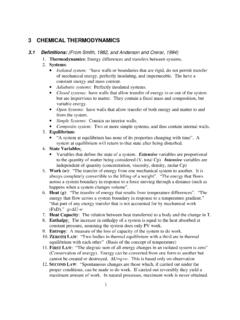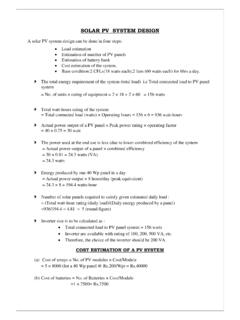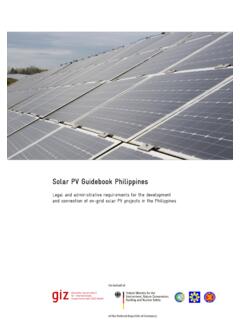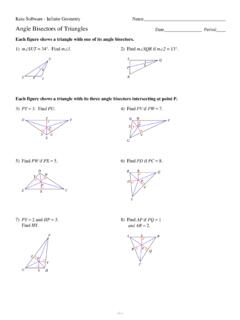Transcription of Renewable Energy Applications for Existing Buildings: Preprint
1 nrel is a national laboratory of the Department of Energy , Office of Energy Efficiency & Renewable Energy , operated by the Alliance for Sustainable Energy , LLC. Contract No. DE-AC36-08GO28308 Renewable Energy Applications for Existing Buildings Preprint Sheila J. Hayter and Alicen Kandt To be presented at the 48th AiCARR International Conference Baveno-Lago Maggiore, Italy September 22-23, 2011 Conference Paper nrel /CP-7A40-52172 August 2011 NOTICE The submitted manuscript has been offered by an employee of the Alliance for Sustainable Energy , LLC (Alliance), a contractor of the US Government under Contract No.
2 DE-AC36-08GO28308. Accordingly, the US Government and Alliance retain a nonexclusive royalty-free license to publish or reproduce the published form of this contribution, or allow others to do so, for US Government purposes. This report was prepared as an account of work sponsored by an agency of the United States government. Neither the United States government nor any agency thereof, nor any of their employees, makes any warranty, express or implied, or assumes any legal liability or responsibility for the accuracy, completeness, or usefulness of any information, apparatus, product, or process disclosed, or represents that its use would not infringe privately owned rights.
3 Reference herein to any specific commercial product, process, or service by trade name, trademark, manufacturer, or otherwise does not necessarily constitute or imply its endorsement, recommendation, or favoring by the United States government or any agency thereof. The views and opinions of authors expressed herein do not necessarily state or reflect those of the United States government or any agency thereof. Available electronically at Available for a processing fee to Department of Energy and its contractors, in paper, from: Department of Energy Office of Scientific and Technical Information Box 62 Oak Ridge, TN 37831-0062 phone: fax: email: Available for sale to the public, in paper, from: Department of Commerce National Technical Information Service 5285 Port Royal Road Springfield, VA 22161 phone: fax: email: online ordering: Cover Photos.
4 (left to right) PIX 16416, PIX 17423, PIX 16560, PIX 17613, PIX 17436, PIX 17721 Printed on paper containing at least 50% wastepaper, including 10% post consumer waste. 1 Renewable Energy Applications for Existing Buildings Applicazioni dell energia rinnovabile su edifici esistenti SHEILA J. HAYTER, PE, FASHRAE ALICEN KANDT Department of Energy s National Renewable Energy Laboratory Integrated Applications Center SUMMARY This paper introduces technical opportunities, means, and methods for incorporating Renewable Energy technologies into building designs and operations. This paper provides an overview of Renewable Energy resources and available technologies used successfully to offset building electrical and thermal Energy loads.
5 Methods for applying these technologies in buildings and the role of building Energy efficiency in successful Renewable Energy projects are addressed. Tips on implementing effective Renewable Energy projects are also provided. RIASSUNTO Questa memoria considera le opportunit tecniche, i mezzi e i metodi per incorporare le tecnologie ad energia rinnovabile (RE) nei progetti e nel uso degli edifici. La memoria fornisce una panoramica delle risorse RE e delle tecnologie disponibile utilizzate con successo per ridurre i carichi elettrici e termici degli edifici. Vengono considerati anche metodi per applicare queste tecnologie negli edifici ed il ruolo dell efficienza energetica nell edificio per progetti RE riusciti.
6 La memoria offre anche suggerimenti per implementare progetti RE ben riusciti. 1. INTRODUCTION Buildings account for approximately 40% of the worldwide annual Energy consumption (WBCSD 2009). Total global Energy consumption in 2007 was 495 quadrillion British thermal units (Btu), meaning the buildings sector consumed about 198 quadrillion Btu. According to the Energy Information Agency, worldwide Energy consumption is expected to increase per year through 2035, implying that buildings will consume 296 quadrillion Btu by the year 2035 (EIA 2010). Fossil fuels meet a majority of world Energy needs and because buildings are a large Energy consumer, they are also a major contributor to global carbon emissions and greenhouse gas (GHG) production.
7 It is now largely recognized that addressing Energy use in buildings can reduce total fossil fuel consumption and associated GHG emissions. Benefits such as decreased building operational Energy costs have prompted growing interest among policy makers, the technical community, and the general public in addressing building Energy issues and investigating solutions for decreasing building Energy consumption. While Energy efficiency is being incorporated into new construction, Existing buildings account for a majority of the building stock that will be in place in the foreseeable future. In his 2009 presidential address, American Society of Heating, Refrigerating, and Air-Conditioning Engineers (ASHRAE) presidential member Gordon Holness stated that 75% to 80% of the buildings that will exist in 2030 already exist today (ASHRAE 2010).
8 This statistic suggests that there is an opportunity for reducing the building sector s contribution toward global Energy consumption through reduction of Energy use in Existing buildings. Reducing Existing building Energy consumption consists of two synergistic approaches: (1) to reduce the need for Energy through implementation of Energy efficiency measures and (2) to offset the remaining building Energy needs through use of Renewable Energy systems (Figure 1). It is important to note that building Energy efficiency measures should be considered first, as the cost to invest in efficiency measures is approximately half the cost of installing Renewable Energy generating capacity equal to what 2 the efficiency measures offset (IEA 2006).
9 It is advised that all Energy efficiency opportunities are explored and as many are implemented as is feasible before or in conjunction with Renewable Energy projects for Existing buildings. It should be noted that this paper focuses only on the opportunities and issues surrounding implementing Renewable Energy projects for Existing buildings. Figure 1. Demonstration of how combining Energy efficiency and Renewable Energy strategies significantly reduce total building conventional Energy use. Source: National Renewable Energy Laboratory National and local policy is being implemented in both developed and developing countries that require greater amounts of Energy to come from Renewable Energy resources.
10 For example, the 2009/28/EC Renewable Energy Sources (RES) Directive requires that 20% of Energy produced within the European Union is from Renewable Energy systems by 2020 compared to 2010 (European Union 2009). Also, the 2002/91/ED Energy Conservation in Buildings Directive requires building Energy labeling and sets standards for Energy performance, including application of Renewable Energy resources (European Union 2002). As policies such as these are enacted, incentives for installing Renewable Energy systems are also being developed and regulatory barriers are being removed.

















